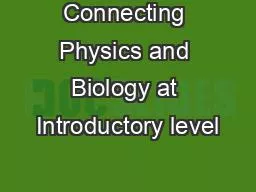

Nava Schulmann 13042015 Past I have a PhD in Physics focused on elastic properties of polymers Present I am a postdoctoral fellow at the ScienceTeaching department of the Weizmann Institute of Science Israel ID: 816211
Download The PPT/PDF document "Connecting Physics and Biology at Introd..." is the property of its rightful owner. Permission is granted to download and print the materials on this web site for personal, non-commercial use only, and to display it on your personal computer provided you do not modify the materials and that you retain all copyright notices contained in the materials. By downloading content from our website, you accept the terms of this agreement.
Slide1
Connecting Physics and Biology at Introductory level
Nava
Schulmann
13/04/2015
Slide2Slide3Past
I have a Ph.D. in Physics focused on elastic properties of polymers.
Slide4Present
I am a post-doctoral
fellow at
the
Science-Teaching department of the Weizmann Institute of Science, Israel
Prof. Samuel
Safran
, Department
of Materials and
Interfaces; Prof. Edit
Yerushalmi
, Dr. Nava Schulman, Dr. Shelly
Livne
, Dr.
Elon Langbheim, Ariel Steiner, Haim Edri, Department of Science Teaching; Dr. Avi Golan, Davidson Institute
Slide5The challenge
However, in the world of research,
interdisciplinary is “the name of the game”
At introductory level, Physics and Biology
are generally taught as
parallel disciplines
.
Idealized, “clean
” systems
1-2 homogenous
bodies, deterministic
explanation
Biology
Complex, “
messy” systems,
multi-particle
,
statistical explanation
Physics
Slide6The program “Randomness and Structure”, a 10-12
th
grade
course
for high
achievers
in the Davidson
Institute, was developed with the aim of bringing students closer to the workshop of science…
B
reak
the borders of content areas:
physics in a chemical and biological context
,
A
cquire
a new language:
the
language of the “cooperative behavior” of multi-particle systems,
D
evelop
new skills:
modeling complex phenomena using analytic
and computational tools.
Prof. Samuel
Safran
, Department
of Materials and
Interfaces; Prof. Edit
Yerushalmi
, Dr. Nava Schulman, Dr. Shelly
Livne
, Dr.
Elon
Langbheim
, Ariel Steiner,
Haim
Edri
, Department
of Science
Teaching; Dr.
Avi
Golan, Davidson Institute
Slide7Curriculum Overview:
from Randomness to Structure…
Unit 2:
Order in Nature
The dynamics of Structure formation: Phase separation, wetting, dimers, polymers, micelles, membranes, liquid crystals…
Unit 1:Randomness in Nature and the nature of randomness
The dynamics of thermal motion governed phenomena:DiffusionOsmosis …and from Mechanistic
to
Statistical approach
Unit 3:
Treating complex systems with probabilistic models
Fundamentals of Statistical Thermodynamics
Slide8Q`
detailed elegant
Molecular Dynamic
s
Paradigm: Newton laws Hard body collisions
Prediction: full trajectories for system and solvent particles
Brownian Motion
Paradigm: Newton laws friction and stochastic forces.
Prediction: trajectories for Brownian particle
Random
Walk
Paradigm: Probabilistic
Prediction
:
system trajectories
Probabilistic model
Paradigm: probabilistic
Prediction: microstates probabilities at equilibrium
Understanding Randomness and Experiencing modeling…
F
our models for Diffusion
Slide9Future
Scaling up:
From
introductory to advanced courses
?
From traditional to open courses?
…
a
nd more personally…
How to keep a serious research activity besides educational engagements?